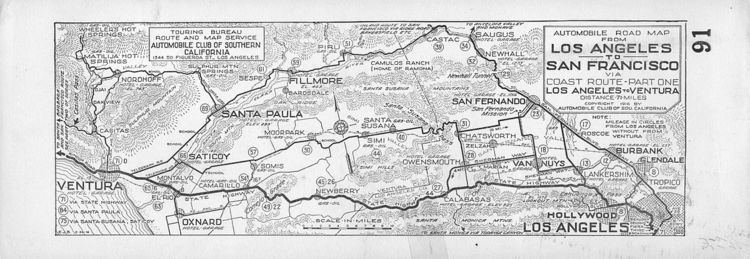Type Historic Postal code 93001 Namesake Rancho El Rincon | Completion 1913 (1913) Commissioned 1911 | |
 | ||
Part of US 101 / SR 1 (Pacific Coast Highway) Known for One of the original U.S. Routes (US 101) | ||
The Rincon Sea Level Road, also known as the Rincon Causeway, connected Ventura and Santa Barbara, California in 1913 with the first driveable coastal automobile route for motorists traveling between San Francisco and Los Angeles, California. The route has become a portion of California State Route 1 and is known as the Rincon Parkway.
History
As the automobile age began, motorists had to follow the Ventura River Valley towards Nordoff to the road over Casitas Pass. Civic boosters were eager for to open the more direct coastal route. The moment came with the construction of the Southern Pacific Railroad's Coast Line. The construction of the railroad had provided an unimproved road flanked by rip-rap but it was often flooded in several sections from the ocean waves. Rock outcroppings has always made travel difficult along this dramatic meeting of the Santa Ynez Mountains with the Pacific Ocean.
Even historical travel by foot or horseback along the small alluvial fan beaches and coastal bluffs often had to wait for the low tide due to the rock outcroppings. A route had been created over Casitas Pass for stagecoach for travel north from Los Angeles since 1861. The pass was still used for stagecoach travel to the Santa Barbara area even after the opening of a tunnel through the San Fernando Pass in 1876 which completed the inland railroad route and provided an alternate means of travel to northern California.
Civic boosters started raising funds locally to pave the road and build wooden causeways where needed. Ventura Resident Eugene Preston Foster was a leader in this effort together with Franklin E. Kellogg, secretary of the Santa Barbara Chamber of Commerce. Sufficient funds to complete the project had not been raised locally when the newly formed State Highway Commission took over and completed the road. Waves hit the pilings during storm surges and regular maintenance was required. In 1926, US 101 was established as one of the original U.S. Routes. The road was modernized with a concrete seawall and the "rickey elevated road was scrapped."
Motor Age magazine from the era described the project in some detail.
"The method of construction is simple. Eucalyptus piles are driven, cross-beams are laid, then the floor of the causeway, and the wooden railings on each side. Asphalt will in time be laid. All causeways are twenty feet wide."
A new bridge over the Ventura River also opened in 1913 when the causeways were complete being forerunners to the impact automobiles would have in the 1920s.
In 1960, a freeway bypass was completed from Emma Wood State Beach north to the Mobil Pier Undercrossing near Sea Cliff. US 101 was then re-routed onto this freeway bypass, while the original two-lane alignment of this portion of the Rincon Sea Level Road was re-signed as part of State Route 1. In other segments of the old Rincon Sea Level Road, US 101 has been upgraded to either a four-lane freeway or expressway.
